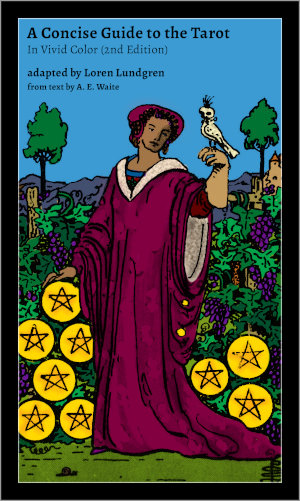Tarot Reading Wlimfrwt?
Reading Performed 08/18/2019 at 6:16 PM
Click or scroll down for the meaning of each position and the interpretation of its card.
Visual Layout
The Meanings of these Tarot Cards
Past
What has already occurred; the past.
The High Priestess from the Waite Smith Tarot Deck
Card Meaning When Reversed
Passion, moral or physical ardour, conceit, surface knowledge.
A. E. Waite's Secondary Meanings (When Upright)
The High Priestess, the Pope Joan, or Female Pontiff; early expositors have sought to term this card the Mother, or Pope's Wife, which is opposed to the symbolism. It is sometimes held to represent the Divine Law and the Gnosis, in which case the Priestess corresponds to the idea of the Shekinah. She is the Secret Tradition and the higher sense of the instituted Mysteries.
Card Description
she has the lunar crescent at her feet, a horned diadem on her head, with a globe in the middle place, and a large solar cross on her breast. The scroll in her hands is inscribed with the word Tora, signifying the Greater Law, the Secret Law and the second sense of the Word. It is partly covered by her mantle, to shew that some things are implied and some spoken. She is seated between the white and black pillars--J. and B.--of the mystic Temple, and the veil of the Temple is behind her: it is embroidered with palms and pomegranates. The vestments are flowing and gauzy, and the mantle suggests light--a shimmering radiance. She has been called occult Science on the threshold of the Sanctuary of Isis, but she is really the Secret Church, the House which is of God and man. She represents also the Second Marriage of the Prince who is no longer of this world; she is the spiritual Bride and Mother, the daughter of the stars and the Higher Garden of Eden. She is, in fine, the Queen of the borrowed light, but this is the light of all. She is the Moon nourished by the milk of the Supernal Mother. In a manner, she is also the Supernal Mother herself--that is to say, she is the bright reflection. It is in this sense of reflection that her truest and highest name in bolism is Shekinah--the co-habiting glory. According to Kabalism, there is a Shekinah both above and below. In the superior world it is called Binah, the Supernal Understanding which reflects to the emanations that are beneath. In the lower world it is MaIkuth--that world being, for this purpose, understood as a blessed Kingdom that with which it is made blessed being the Indwelling Glory. Mystically speaking, the Shekinah is the Spiritual Bride of the just man, and when he reads the Law she gives the Divine meaning. There are some respects in which this card is the highest and holiest of the Greater Arcana.
Present
What is occurring now; the present.
Death from the Waite Smith Tarot Deck
Card Meaning When Reversed
Inertia, sleep, lethargy, petrifaction, somnambulism; hope destroyed.
A. E. Waite's Secondary Meanings (When Upright)
Death. The method of presentation is almost invariable, and embodies a bourgeois form of symbolism. The scene is the field of life, and amidst ordinary rank vegetation there are living arms and heads protruding from the ground. One of the heads is crowned, and a skeleton with a great scythe is in the act of mowing it. The transparent and unescapable meaning is death, but the alternatives allocated to the symbol are change and transformation. Other heads have been swept from their place previously, but it is, in its current and patent meaning, more especially a card of the death of Kings. In the exotic sense it has been said to signify the ascent of the spirit in the divine spheres, creation and destruction, perpetual movement, and so forth.
Card Description
The veil or mask of life is perpetuated in change, transformation and passage from lower to higher, and this is more fitly represented in the rectified Tarot by one of the apocalyptic visions than by the crude notion of the reaping skeleton. Behind it lies the whole world of ascent in the spirit. The mysterious horseman moves slowly, bearing a black banner emblazoned with the Mystic Rose, which signifies life. Between two pillars on the verge of the horizon there shines the sun of immortality. The horseman carries no visible weapon, but king and child and maiden fall before him, while a prelate with clasped hands awaits his end. There should be no need to point out that the suggestion of death which I have made in connection with the previous card is, of course, to be understood mystically, but this is not the case in the present instance. The natural transit of man to the next stage of his being either is or may be one form of his progress, but the exotic and almost unknown entrance, while still in this life, into the state of mystical death is a change in the form of consciousness and the passage into a state to which ordinary death is neither the path nor gate. The existing occult explanations of the 13th card are, on the whole, better than usual, rebirth, creation, destination, renewal, and the rest.







.jpg)
